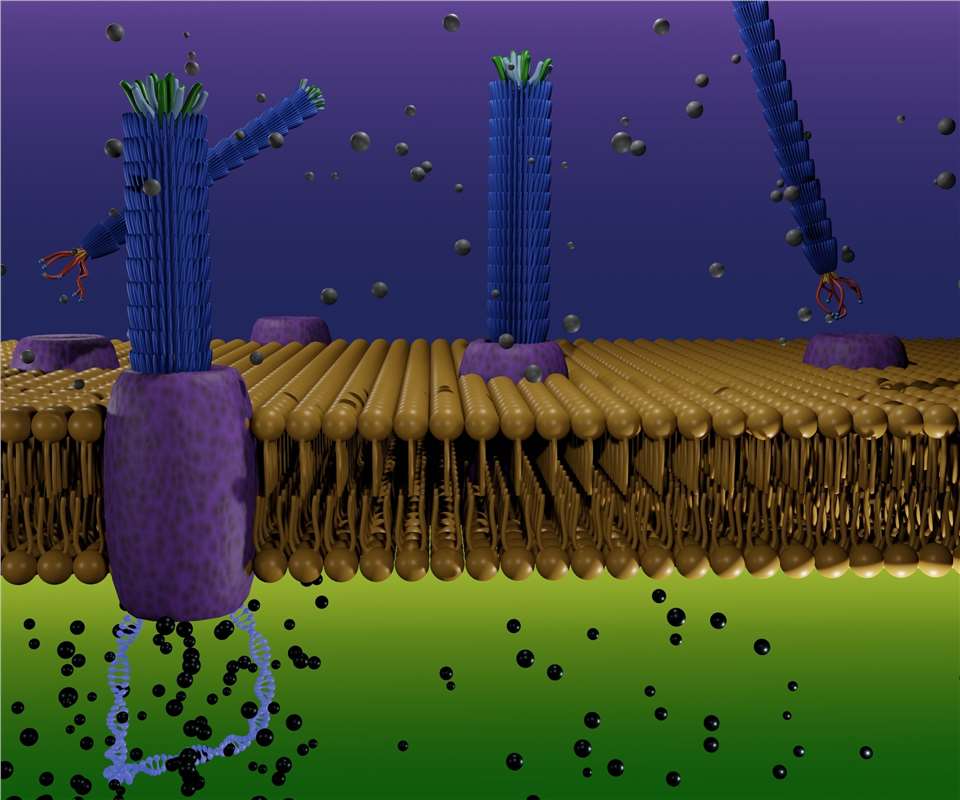Phage display technology has shown significant application value in the biomedical field. It has played an important role in the development of novel diagnostic reagents and vaccines, especially in the field of therapeutic antibody discovery. Phage antibody display technology allows for the targeted development of therapeutic antibodies for different purposes, which greatly reduces the time required for antibody development and the chance of failure. One of the ways in which therapeutic antibodies work is by activating or blocking the activity of the target, thereby modulating the disease process. As phage antibody library technology continues to improve in terms of capacity and affinity, it will play an increasingly important role in the development of therapeutic antibodies. Based on our rich field experience and advanced research platform, Creative Biolabs provides comprehensive services to support phage display and agonistic & antagonistic antibody discovery.
 Fig 1. Life cycle of filamentous bacteriophage M13.
Fig 1. Life cycle of filamentous bacteriophage M13.
Phage display technology utilizes the method of genetic recombination to recombine the genes of target proteins with the genes of phage coat proteins and finally display the target proteins as fusion proteins on the surface of phage. With the increasing application of phage display technology in the antibody field, phage display antibody libraries play an important role in antibody development. In particular, the important role played by immune checkpoint agonistic & antagonistic antibodies and neutralizing antibodies in the field of oncology has led to the additional therapeutic activity of therapeutic antibodies. The two core steps of phage display technology are antibody library construction and antibody library screening.
Inhibitory antibodies are an important direction in the development of therapeutic antibodies. When immune cells are stimulated by exogenous antigens, they regulate the activation of co-stimulatory signals as well as the inhibition of co-inhibitory signals to avoid autoimmunity and tissue damage. These co-stimulatory signals, as well as their co-suppressive signals, form immune checkpoints that precisely regulate the function of immune cells. Cancer cells will escape killing by immune cells by inhibiting the immune checkpoint signaling pathway. PD-1/PD-L1 is the target of a very successful immune checkpoint inhibitor antibody, which can re-establish the killing effect of immune cells on cancer cells by disarming the immune escape of cancer cells.
As inhibitory antibodies play more and more roles in the field of disease treatment, agonistic antibodies, as opposed to inhibitory antibodies, are gradually being emphasized by scientists. The targets of immune agonistic antibodies are mainly focused on the B7-CD28 family and the TNFR family of immunoglobulin and tumor necrosis factor receptor (TNFR) superfamilies. Despite the dangerous history of agonist antibody development, we cannot deny its role in the field of disease treatment. Therefore, in the development of agonist antibodies, more attention needs to be paid to the safety margins of agonist antibodies, while combination therapies can be tried to discover the potential therapeutic role of agonist antibodies.
Neutralizing antibodies are antibodies that are used to protect cells from a certain antigen or infectious agent. Neutralizing antibodies have an important role in viral infections. Previous studies have focused on the therapeutic role of neutralizing antibodies. With the deepening of research, scientists gradually verified the preventive role of neutralizing antibodies, that is, exploring whether neutralizing antibodies can possess the role of protecting the organism from infection before viral exposure. For COVID-19 infection, neutralizing antibody is one of the important strategies for effective prevention and treatment.
In addition, disease-specific peptide discovery is important indication for drug development, such as mimotopes. The phage display peptide library allows rapid selection of specific peptides for the corresponding targets. Antibodies to a given epitope antigen will recognize mimotopes that mimic the epitope. Mimotope analysis has been widely used as a binding site mimic to map epitopes and drug targets and infer protein interaction networks. It has great potential for the development of therapeutic antibodies, vaccines, diagnostics, and so on.
Introduction to Agonistic and Antagonistic Antibody Discovery by Phage Display
Introduction to Internalizing Antibody Discovery by Phage Display
Introduction to pH-sensitive Biomolecule Discovery by Phage Display
Introduction to Stable Variants of Protein Domains Discovery by Phage Display
Introduction to Thermal Stable mAb Discovery by Phage Display
Creative Biolabs has a wealth of knowledge and experience in phage display. We would be happy to share with you our knowledge and experience in phage display.
All listed services and products are For Research Use Only. Do Not use in any diagnostic or therapeutic applications.
| USA:
Europe: Germany: |
|
|
Call us at: USA: UK: Germany: |
|
|
Fax:
|
|
| Email: info@creative-biolabs.com |
